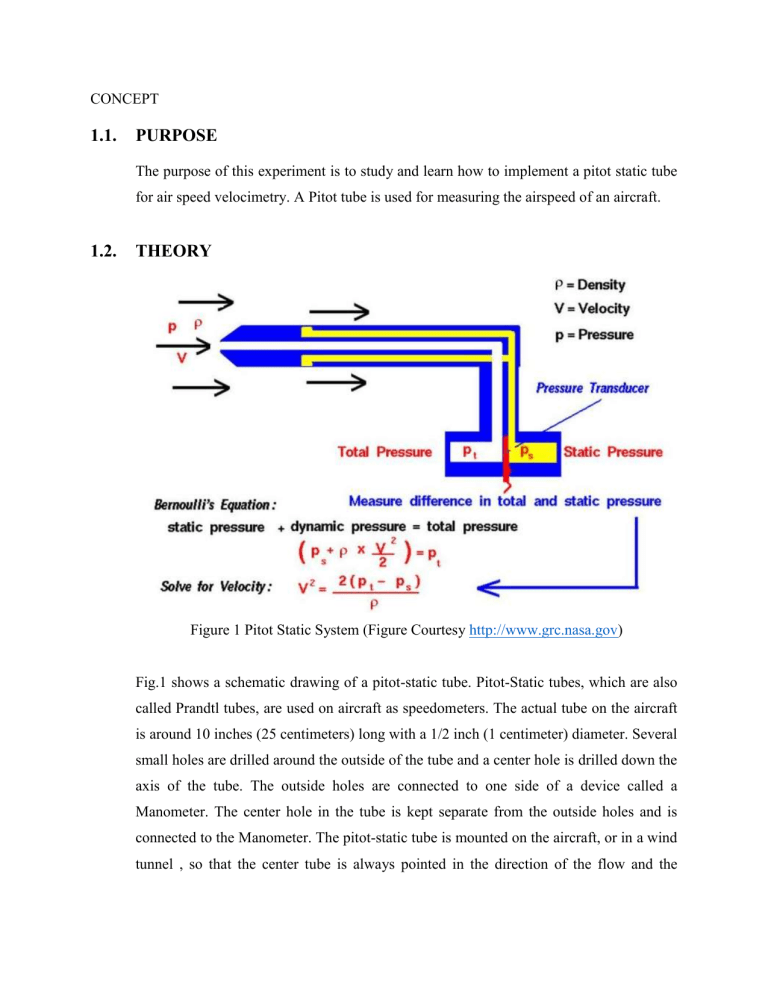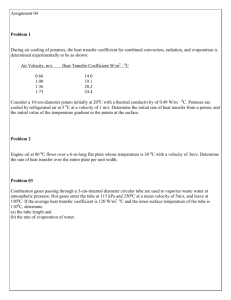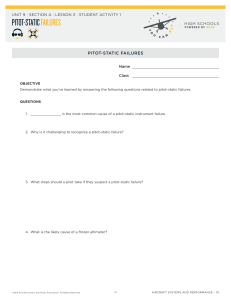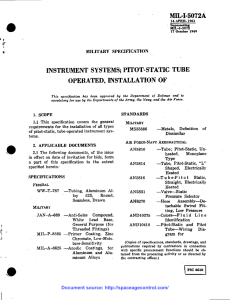Experiment #2 (16/12/2015)

CONCEPT
1.1.
PURPOSE
The purpose of this experiment is to study and learn how to implement a pitot static tube for air speed velocimetry. A Pitot tube is used for measuring the airspeed of an aircraft.
1.2.
THEORY
Figure 1 Pitot Static System (Figure Courtesy http://www.grc.nasa.gov
)
Fig.1 shows a schematic drawing of a pitot-static tube. Pitot-Static tubes, which are also called Prandtl tubes, are used on aircraft as speedometers. The actual tube on the aircraft is around 10 inches (25 centimeters) long with a 1/2 inch (1 centimeter) diameter. Several small holes are drilled around the outside of the tube and a center hole is drilled down the axis of the tube. The outside holes are connected to one side of a device called a
Manometer. The center hole in the tube is kept separate from the outside holes and is connected to the Manometer. The pitot-static tube is mounted on the aircraft, or in a wind tunnel , so that the center tube is always pointed in the direction of the flow and the
outside holes are perpendicular to the center tube. On some airplanes the pitot-static tube is put on a longer boom sticking out of the nose of the plane or the wing.
Difference in Static and Total Pressure:
Since the outside holes are perpendicular to the direction of flow, these tubes are pressurized by the local random component of the air velocity. The pressure in these tubes is the static pressure ( P ) discussed in Bernoulli's equation. The center tube,
S however, is pointed in the direction of travel and is pressurized by both the random and the ordered air velocity. The pressure in this tube is the total pressure ( P
T
) discussed in
Bernoulli's equation. The difference in total and static pressure can be measured from the manometer which is called the dynamic pressure q.
Measurement
P
T
P
S
Solve for Velocity
With the difference in pressures measured and knowing the local value of air density from pressure and temperature measurements, we can use Bernoulli's equation to give us the velocity. Bernoulli's equation states that the static pressure plus one half the density times the velocity V squared is equal to the total pressure.
V
2( P
T
P
S
)
= √
2𝜌 𝑤𝑎𝑡𝑒𝑟 𝑔(ℎ
2 𝜌 𝑎𝑖𝑟
−ℎ
1
) or
P
T
P
S
V
2
2
Limitations
If the velocity is low, the difference in pressures is very small and hard to accurately measure with the transducer. Errors in the instrument could be greater than the measurement! So pitot-static tubes don't work very well for very low velocities.
If the velocity is very high (supersonic), we've violated the assumptions of
Bernoulli's equation and the measurement is wrong again. At the front of the tube, a shock wave appears that will change the total pressure. There are corrections for the shock wave that can be applied to allow us to use pitot-static tubes for high speed aircraft.
If the tubes become clogged or pinched, the resulting pressures at the transducer are not the total and static pressures of the external flow. The transducer output is then used to calculate a velocity that is not the actual velocity of the flow. Several years ago, there were reports of icing problems occuring on airliner pitot-static probes. Output from the probes was used as part of the auto-pilot and flight control system. The solution to the icing problem was to install heaters on the probes to insure that the probe was not clogged by ice build-up.
2.
REQUIRED EQUIPMENT
Wind Tunnel
Manometer
Pitot Tube





